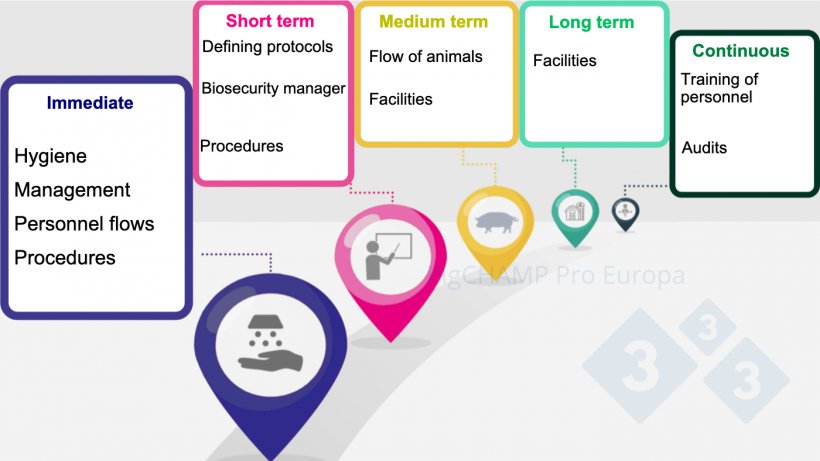Livestock farming today, both in general and pig farming in particular, faces a number of important legislative, health, and environmental challenges such as the reduction of antibiotic use, emissions, health threats, etc. This situation means that prevention is becoming increasingly more important and biosecurity certainly has a very important role to play in this field.
Within this context, many companies are carefully addressing biosecurity, both by improving farms that are already at a high level and by upgrading those that have lagged behind. In the following article we will outline, in our experience, how a biosecurity improvement plan can be organized.

First things first, a biosecurity improvement plan should always be preceded by some kind of analysis or audit that reviews all aspects involved in the biosecurity of the farm or company point by point. These methods of analysis can be carried out by external consultants or by internal personnel, the important thing is that the chosen method provides us with information and organized data that will help us to focus our efforts on the appropriate objectives.
Typically, these methods are:
- More or less detailed biosecurity surveys. Obviously, the more detailed and less subjective the survey, the better information we will obtain.
- Checklist/reviews of protocols, facilities, etc. You could say this is another way of doing surveys.
- Digital biosecurity monitoring/analysis systems that provide objective data on personnel/route interactions, disinfection methods, etc.
As a general rule, these methods give us a score out of 100 (or any other scale) for different aspects of the biosecurity of a farm or company, pointing out the specific points in which we have deficiencies: visitor access, management, loading bays, quarantines, truck routes, etc. Because biosecurity is so complex and encompasses so many different aspects on a farm, it can be overwhelming to deal with all the changes at once, and an improvement plan needs to be organized to move forward efficiently.
Let's suppose that after auditing a farm we find 15 aspects that can be improved (in many cases there are risks that we cannot avoid, such as being located in an area of high livestock density). The organization of the plan must be balanced between the potential risk involved and the time it takes to resolve these aspects. Thus, the objectives are organized in a timeframe (Figure 1):
- Immediate objectives. Those that require little time or financial investment to implement: improving hygiene, simple procedures such as changing needles, modifying personnel flows, or changing protocols such as the loading process.
- Short-term objectives. These don't usually imply a significant cost, but they do require a little more time to be implemented: definition of biosecurity protocols, looking for a biosecurity manager, changing more complex procedures such as ensuring a true AI-AO.
-
Medium-term objectives. In this case, economic investments and time are needed to carry them out. They are usually related to changes in the flow of animals (e.g., quarantine entries) or changes in facilities.
Medium-term objectives are the most contentious in our experience, and we demonstrate this with one of the most commonly encountered examples: the loading bay.
When a loading bay has deficiencies, the risk score it usually receives in surveys/audits/data is very high, but sometimes time is needed to improve it. This contradiction of being exposed to a high risk, but not being able to reduce the risk quickly often creates confusion and sometimes the improvement plan can get stuck because fo it. Our recommendation is simple: improve the loading bay as soon as possible; but in the meantime, set immediate objectives by changing bay protocols and increasing hygiene to reduce the risk in that area until the facility can be modified.
-
Long-term objectives. In this case, large investments of time and money are needed: building new quarantine facilities, vehicle washing and disinfection centers, etc. As in the previous case, the risk can be reduced with other simpler measures until the long-term objectives are achieved.
-
Continuous objectives. Periodically train new and existing workers (the best biosecurity plan is useless if the staff does not understand it), and evaluate your own biosecurity by conducting both internal and external audits.
Figure 1.











